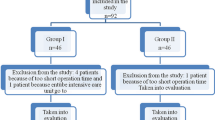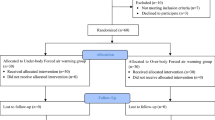Abstract
Background
The effect of the Mega Acer kit@, a new heated and humidified breathing circuit (HHBC) containing a fluid-warming device, was investigated on intraoperative core temperature (T c).
Methods
A total of 102 patients undergoing elective craniotomies were randomly divided into three groups based on the breathing circuit used: a conventional breathing circuit (group C, n = 34), a Fisher & Paykel HHBC (group F, n = 34), and the Mega (group M, n = 34). From baseline to the end of the surgery, T c and infusion fluid temperature (T f) were recorded at 15-min intervals. If T c became lower than 35.5 °C, a forced-air warmer was used.
Results
Baseline temperatures were 36.7 ± 0.3, 36.6 ± 0.2, and 36.6 ± 0.2 °C in groups C, M, and F, respectively. T c at the end of surgery dropped from baseline values by 1.0 ± 0.4, 0.5 ± 0.5, and 0.8 ± 0.5 °C in groups C, M, and F, respectively. From 60 min of post-induction to the end of surgery, T c was higher in group M than group C (p < 0.05). From 105 min of post-induction to the end of surgery, T c was higher in group M than group F (p < 0.05). The number of patients receiving forced-air warmer and total forced-air warmer using time were significantly lower in group M than groups C and F (p < 0.05). T f was higher in group M than groups C and F throughout the study period (31.0 ± 1.0 vs. 23.5 ± 0.5 and 24.0 ± 0.4 °C; p < 0.01).
Conclusions
The Mega significantly reduced the drop in intraoperative T c by delivering warm fluids, compared with the other breathing circuits tested.
Trial Registration
Clinicaltrials.gov identifier: NCT01831843.





Similar content being viewed by others
References
Rohrer MJ, Natale AM. Effect of hypothermia on the coagulation cascade. Crit Care Med. 1992;20:1402–5.
Rajagopalan S, Mascha E, Na J, Sessler DI. The effects of mild perioperative hypothermia on blood loss and transfusion requirement. Anesthesiology. 2008;108:71–7.
Lenhardt R, Marker E, Goll V, Tschernich H, Kurz A, Sessler DI, Narzt E, Lackner F. Mild intraoperative hypothermia prolongs postanesthetic recovery. Anesthesiology. 1997;87:1318–23.
Polderman KH. Mechanisms of action, physiological effects, and complications of hypothermia. Crit Care Med. 2009;37:S186–202.
Camus Y, Delva E, Cohen S, Lienhart A. The effects of warming intravenous fluids on intraoperative hypothermia and postoperative shivering during prolonged abdominal surgery. Acta Anaesthesiol Scand. 1996;40:779–82.
Ihn CH, Joo JD, Chung HS, Choi JW, Kim DW, Jeon YS, Kim YS, Choi WY. Comparison of three warming devices for the prevention of core hypothermia and post-anaesthesia shivering. J Int Med Res. 2008;36:923–31.
Smith CE, Gerdes E, Sweda S, Myles C, Punjabi A, Pinchak AC, Hagen JF. Warming intravenous fluids reduces perioperative hypothermia in women undergoing ambulatory gynecological surgery. Anesth Analg. 1998;87:37–41.
Yoo HS, Park SW, Yi JW, Kwon MI, Rhee YG. The effect of forced-air warming during arthroscopic shoulder surgery with general anesthesia. Arthroscopy. 2009;25:510–4.
Matsukawa T, Sessler DI, Sessler AM, Schroeder M, Ozaki M, Kurz A, Cheng C. Heat flow and distribution during induction of general anesthesia. Anesthesiology. 1995;82:662–73.
Nakagawa NK, Macchione M, Petrolino HM, Guimaraes ET, King M, Saldiva PH, Lorenzi-Filho G. Effects of a heat and moisture exchanger and a heated humidifier on respiratory mucus in patients undergoing mechanical ventilation. Crit Care Med. 2000;28:312–7.
Hynson JM, Sessler DI. Intraoperative warming therapies: a comparison of three devices. J Clin Anesth. 1992;4:194–9.
Lee HK, Jang YH, Choi KW, Lee JH. The effect of electrically heated humidifier on the body temperature and blood loss in spinal surgery under general anesthesia. Korean J Anesthesiol. 2011;61:112–6.
Stone DR, Downs JB, Paul WL, Perkins HM. Adult body temperature and heated humidification of anesthetic gases during general anesthesia. Anesth Analg. 1981;60:736–41.
Goldberg ME, Epstein R, Rosenblum F, Larijani GE, Marr A, Lessin J, Torjman M, Seltzer J. Do heated humidifiers and heat and moisture exchangers prevent temperature drop during lower abdominal surgery? J Clin Anesth. 1992;4:16–20.
Jo YY, Kim HS, Chang YJ, Yun SY, Kwak HJ. The effect of warmed inspired gases on body temperature during arthroscopic shoulder surgery under general anesthesia. Korean J Anesthesiol. 2013;65:14–8.
Ralley FE, Ramsay JG, Wynands JE, Townsend GE, Whalley DG, DelliColli P. Effect of heated humidified gases on temperature drop after cardiopulmonary bypass. Anesth Analg. 1984;63:1106–10.
Kwak IS, Choi do Y, Lee TH, Bae JY, Lim TW, Kim KM. The effect of heated breathing circuit on body temperature and humidity of anesthetic gas in major burns. Korean J Anesthesiol. 2013;64:6–11.
Kaufman RD. Relationship between esophageal temperature gradient and heart and lung sounds heard by esophageal stethoscope. Anesth Analg. 1987;66:1046–8.
Sessler DI. Perioperative heat balance. Anesthesiology. 2000;92:578–96.
Leslie K, Sessler DI. Reduction in the shivering threshold is proportional to spinal block height. Anesthesiology. 1996;84:1327–31.
Turner M, Hodzovic I, Mapleson WW. Simulated clinical evaluation of four fluid warming devices. Anaesthesia. 2006;61:571–5.
Presson RG Jr, Bezruczko AP, Hillier SC, McNiece WL. Evaluation of a new fluid warmer effective at low to moderate flow rates. Anesthesiology. 1993;78:974–80.
Horowitz PE, Delagarza MA, Pulaski JJ, Smith RA. Flow rates and warming efficacy with Hotline and Ranger blood/fluid warmers. Anesth Analg. 2004;99:788–92.
de Castro J Jr, Bolfi F, Carvalho LR, Braz JR. The temperature and humidity in a low-flow anesthesia workstation with and without a heat and moisture exchanger. Anesth Analg. 2011;113:534–8.
Chalon J, Loew DA, Malebranche J. Effects of dry anesthetic gases on tracheobronchial ciliated epithelium. Anesthesiology. 1972;37:338–43.
Pollett HF, Reid WD. Prevention of obstruction of nasopharyngeal CPAP tubes by adequate humidification of inspired gases. Can Anaesth Soc J. 1977;24:615–7.
Jung TH, Rho JH, Hwang JH, Lee JH, Cha SC, Woo SC. The effect of the humidifier on sore throat and cough after thyroidectomy. Korean J Anesthesiol. 2011;61:470–4.
Patel N, Smith CE, Pinchak AC, Hagen JF. Comparison of esophageal, tympanic, and forehead skin temperatures in adult patients. J Clin Anesth. 1996;8:462–8.
Acknowledgments
This work was supported by 2012 Small and Medium Business Administration, Republic of Korea.
Conflict of interest
The authors declare that they have no competing interests.
Author information
Authors and Affiliations
Corresponding author
About this article
Cite this article
Kim, E., Lee, SY., Lim, YJ. et al. Effect of a new heated and humidified breathing circuit with a fluid-warming device on intraoperative core temperature: a prospective randomized study. J Anesth 29, 499–507 (2015). https://doi.org/10.1007/s00540-015-1994-z
Received:
Accepted:
Published:
Issue Date:
DOI: https://doi.org/10.1007/s00540-015-1994-z




